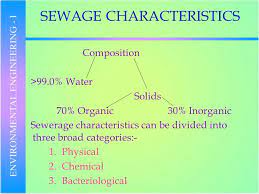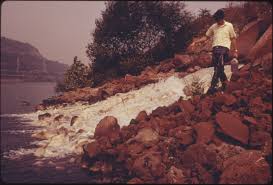Domestic waste-water or sewage contains human waste like feaces, urine, and gray water. Gray water results from washing, bathing and meal preparations. Agricultural run-off water and waste from nearby industries may also enter the system.
The important physical characteristic of the waste-water is its total solids content. It includes floating, suspended, colloidal and dissolved solids. Total solids are those that remain as residue upon evaporation at 105°C. The Total solids include suspended and filterable solids (about 1μ size).
Settlable suspended solids are the ones that settle in Imhoff cone in 60 min., while the remaining are non-settlable solids. Colloidal filterable solids impart turbidity to the water, measurement of which gives an idea about the waste-water quality.
Dissolved filterable solids cannot be removed by conventional treatment and requires special treatment. Solids are called volatile solids if they are volatile at 600°C. Minerals are non-volatile solids that form ash when heated at 600°C.
Read Also: Principles of Applied Microbiology
Depending on the amount of total suspended solids the sewage can be categorized as high strength (>500 ppm), medium strength (200-500 ppm) and weak (< 200 ppm).
The odor in sewage usually is due to presence of amines, hydrogen sulfide, ammonia, organic sulfide etc. The color of fresh sewage is usually gray.

After the organics are broken down the dissolved oxygen is depleted and the color changes to black. The chemical nature of a typical municipal sewage is primarily due to proteins, carbohydrates and fats.
Surfactants, detergents, phenols, pesticides etc. form the minor components. Roughly the composition of the sewage can be represented in terms of its contents of the table below:
Table: Composition of Average Sewage
| S./N | Component | mg/L | Component | mg/L | Component | mg/L |
| 1. | Total solids | 700 | TOC | 200 | NO -N3 | 0-1 |
| 2. | Dissolved solids | 500 | COD | 400 | Total P | 10 |
| 3. | Settled solids | 300 | Total N | 40 | Organic P | 3 |
| 4. | Suspended solids | 200 | Organic N | 15 | Inorganic P | 7 |
| 5. | BOD | 300 | NH -N3 | 25 | Grease | 100 |
The need for characterization of sewage arises in order to evaluate its capacity to cause pollution, decide correct type and size of the treatment plants, monitor the efficiency of the plant, and prevent the pollution of the receiving water. It helps to establish an effective and economical waste management system.
Read Also: 19 Medicinal Health Benefits Of Avens (Geum)

